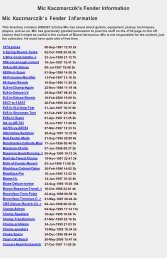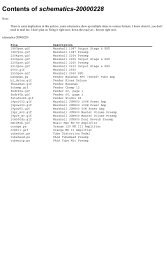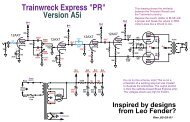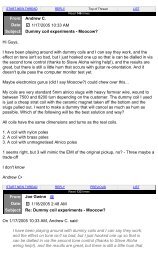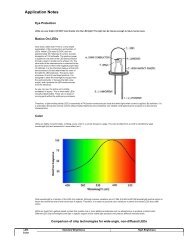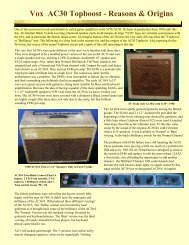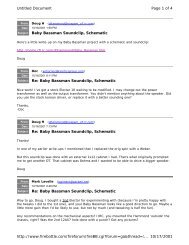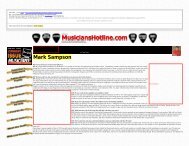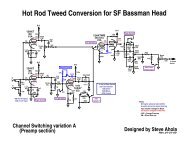- Page 1 and 2: Mic Kaczmarczik's Tube Information
- Page 3 and 4: Svetlana-6550s 07-Nov-1995 11:01 4k
- Page 5 and 6: From ftom@netcom.com Sun Mar 26 14:
- Page 7 and 8: From wright@uspto.gov Sat Aug 19 20
- Page 9 and 10: From tremolux@aol.com Tue Dec 20 11
- Page 11 and 12: From hap@bnr.ca Fri Mar 1 16:51:56
- Page 13 and 14: : : : What transformer secondary vo
- Page 15 and 16: At continuous DC current of 100mA .
- Page 17 and 18: From stratboy@onramp.nett Sun Dec 1
- Page 19 and 20: From power@wwdc.com Tue Sep 3 09:41
- Page 21 and 22: From ashinman@chem.ucalgary.ca Wed
- Page 23 and 24: From postmaster@triodeel.com Wed De
- Page 25 and 26: From mookie2112@aol.com Sat Jul 31
- Page 27 and 28: tubes. Very good in the #2 position
- Page 29 and 30: From postmaster@triodeel.com Thu Au
- Page 31 and 32: Organization: Univ of CT Health Cen
- Page 33 and 34: From raydeeohh@aol.com Mon Jan 30 1
- Page 35 and 36: Back to JT30 Home
- Page 37: From power@wwdc.com Mon Jul 29 10:3
- Page 41 and 42: From SRSN81A@prodigy.com Sat Nov 25
- Page 43 and 44: From postmaster@triodeel.com Sun No
- Page 45 and 46: From rongon@bway.net Tue Jul 9 01:0
- Page 47 and 48: RCA - Very detailed when clean, sli
- Page 49 and 50: From larrysb@aol.comNOspahm Tue Dec
- Page 51 and 52: From meo@rru.com Wed Apr 19 14:02:1
- Page 53 and 54: From SRSN81A@prodigy.com Sat Aug 19
- Page 55 and 56: it!) with a well matched set of GTA
- Page 57 and 58: From tremolux@aol.com Fri May 19 22
- Page 59 and 60: From Kevin@UPSCALEaudio.com Sun Mar
- Page 61 and 62: From robertc908@aol.com Sun Jan 18
- Page 63 and 64: From ebarbour@netcom.com Sun Jun 18
- Page 65 and 66: From tekman@execpc.com Thu Oct 17 1
- Page 67 and 68: From postmaster@triodeel.com Fri Oc
- Page 69 and 70: From dpowers@jeeves.la.utexas.edu T
- Page 71 and 72: From npstewar@eos.ncsu.edu Thu Apr
- Page 73 and 74: Lines: 110 Message-ID: References:
- Page 75 and 76: 6: enne-al 9-pin 7 is also a "misce
- Page 77 and 78: From triodeel@ameritech.net Wed Jun
- Page 79 and 80: From ebarbour@netcom.com Sat Aug 26
- Page 81 and 82: From Kevin@UpscaleAudio.com Wed May
- Page 83 and 84: From tremolux@aol.com Sat Oct 1 00:
- Page 85 and 86: it beefier magnetics and they can h
- Page 87 and 88: little gift of a bad trace, a bad L
- Page 89 and 90:
From svetengr@aol.com Fri Mar 7 22:
- Page 91 and 92:
From dhaugen9@mail.idt.net Fri Oct
- Page 93 and 94:
with the numbers on top in a grey p
- Page 95 and 96:
From: jatwood@netcom.com (John Atwo
- Page 97 and 98:
Back to JT30 Home
- Page 99 and 100:
From jjensen@sirius.com Wed Apr 30
- Page 101 and 102:
(2) When the Chinese tried making 6
- Page 103 and 104:
Many of Mazda's later tubes were ma
- Page 105 and 106:
From Dr.Distortion@bbs.mhv.net Wed
- Page 107 and 108:
From jjensen@sirius.com Fri May 2 1
- Page 109 and 110:
From tomhiwatt@aol.com Thu Nov 21 1
- Page 111 and 112:
From postmaster@triodeel.com Sun Au
- Page 113 and 114:
From Teleologist@Sorry.NoEmail Thu
- Page 115 and 116:
lack paint. This is a good case for
- Page 117 and 118:
coupling in airborne sound to the t
- Page 119 and 120:
UPSCALE Audio/Home Theater/Rare Tub
- Page 121 and 122:
From stanj@dnai.com Sun Nov 19 10:5
- Page 123 and 124:
From jcassidy@svetlana.com Thu Oct
- Page 125 and 126:
small, so it could have been plain
- Page 127 and 128:
From larrysb@aol.com Sat Aug 31 09:
- Page 129 and 130:
From lewis@jpmorgan.com Wed Apr 17
- Page 131 and 132:
4. The first grid voltage -35 V 5.
- Page 133 and 134:
From PYLOT@asu.edu Tue Sep 19 11:35
- Page 135 and 136:
From grego@mud.lattice.com Thu Feb
- Page 137 and 138:
or control grid is sloppy. As you k
- Page 139 and 140:
From ep@interport.net Fri Jul 28 15
- Page 141 and 142:
From PYLOT@asu.edu Tue Aug 8 11:34:
- Page 143 and 144:
From postmaster@triodeel.com Sat Oc
- Page 145 and 146:
From idkwid@mail.smart.net Tue Nov
- Page 147 and 148:
From larrysb@aol.com Sat Oct 26 00:
- Page 149 and 150:
From larrysb@aol.com Thu May 16 10:
- Page 151 and 152:
From tremolux@aol.com Sun Oct 16 09
- Page 153 and 154:
From postmaster@triodeel.com Wed Fe
- Page 155 and 156:
From joelnice@diva.EECS.Berkeley.ED
- Page 157 and 158:
Subject: Re: Tomorrow's tubes? Send
- Page 159 and 160:
From mcjimi@aol.com Fri May 12 12:4
- Page 161 and 162:
mirrors. Or try: "It is also availa
- Page 163 and 164:
8. Output transformer questions: >
- Page 165 and 166:
potential and plate potential, tran
- Page 167 and 168:
> A recently voiced although intuit
- Page 169 and 170:
* "rewinding transformers with CAD"
- Page 171 and 172:
From triodeel@interserv.com Wed Apr
- Page 173 and 174:
Best Regards, Kevin Deal High End,
- Page 175 and 176:
From bry@REMOVETHIS.mnsinc.com Sat
- Page 177 and 178:
From keen@austin.ibm.com Thu Mar 21
- Page 179 and 180:
Sovtek also markets 5U4G, 5Y3GT, 6S
- Page 181 and 182:
From rcsigurd@mm.com Tue Dec 17 15:
- Page 183 and 184:
The two, three, and four digit indu
- Page 185 and 186:
AEG/Telefunken themselves aren't ab
- Page 187 and 188:
From ftom@netcom.com Mon Jun 26 21:
- Page 189 and 190:
By incorporating a tube rectifier i
- Page 191 and 192:
+++ +++ +++ -+---+---+---+---+---+-
- Page 193 and 194:
From keen@austin.ibm.com Sat Aug 13
- Page 195 and 196:
splitter in many hifi amps, lots of
- Page 197 and 198:
Here's the tough one: Why hasn't an
- Page 199 and 200:
The price for matched pairs/quads i
- Page 201 and 202:
which case you use unscew and remov
- Page 203 and 204:
From ebarbour@netcom.com Fri Sep 1
- Page 205 and 206:
From triodeel@interserv.com Fri May
- Page 207 and 208:
Ned Carlson Triode Electronics 2225
- Page 209 and 210:
From postmaster@triodeel.com Tue Ma
- Page 211 and 212:
From dawsondc@postoffice.worldnet.a
- Page 213 and 214:
After that, people wanted radios in
- Page 215 and 216:
I was given one answer which I thin
- Page 217 and 218:
From postmaster@triodeel.com Sat Se



